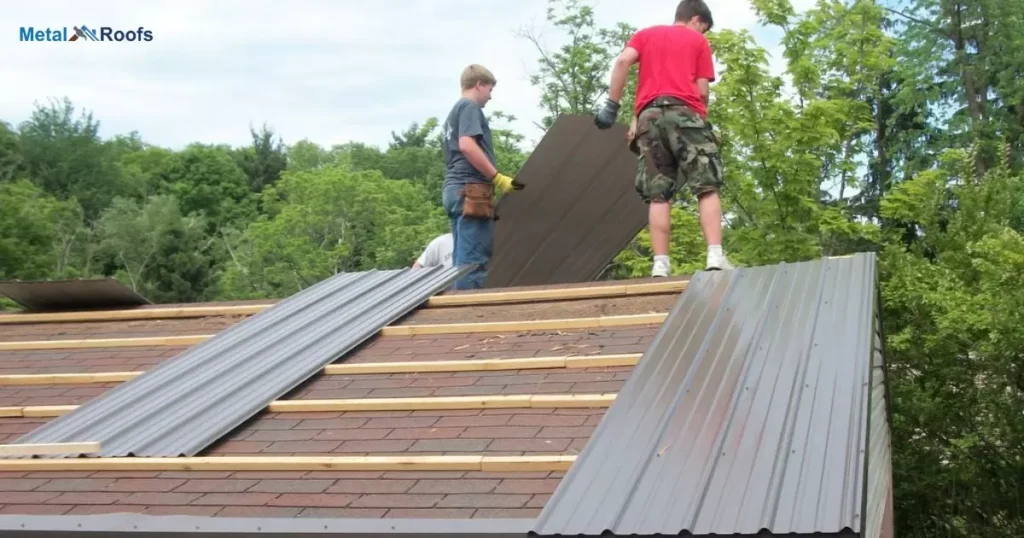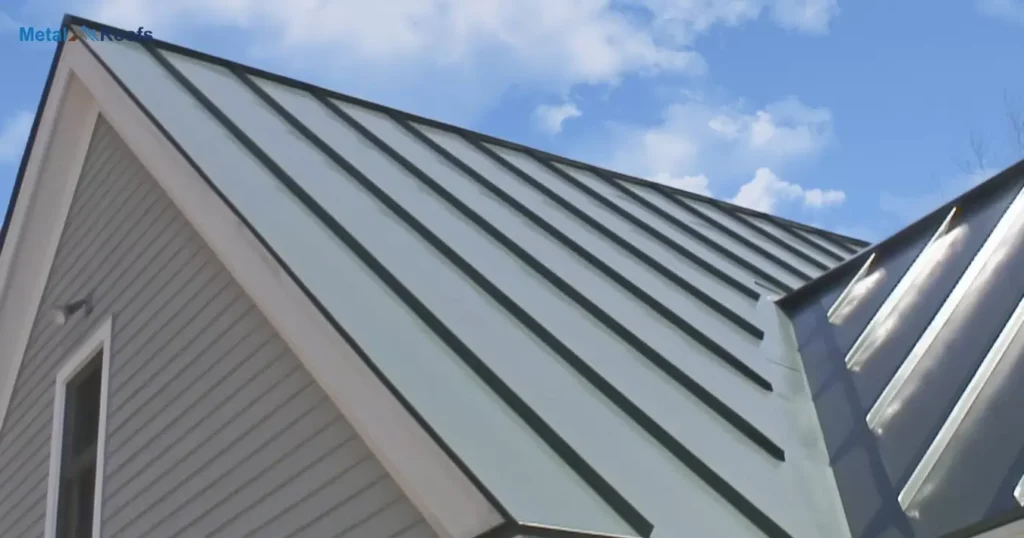Metal roofing requires accuracy. Measure roof area precisely. Count squares for material needs. Determine roof pitch for safety. Account for hips, valleys, ridges. Consider underlayment and fasteners. Prepare for waste and cutting loss. Verify local codes and permits. Proper measuring ensures success.
Metal roofs demand precision. Accurate measurements are critical. Miscalculations lead to costly errors. measure for metal roofing is vital. Proper planning prevents problems. Careful measuring ensures success. Follow best practices for safety. Attention to detail pays off.
Metal roofs demand precise measurements to avoid expensive errors. When insulate a metal building, thorough planning is crucial. Measure twice, install once, factoring in roof pitch, obstacles, valleys, and ridges. Proper tools and a systematic approach guarantee success.
Key Takeaways
- Tape measure, notepad, calculator, ladder, safety gear.
- Draw and label each roof section.
- Record length and width, calculate area.
- Measure rise/run, use pitch multiplier.
- Multiply area by pitch multiplier.
- Sum adjusted areas of all sections.
Metal Roof Material
Metal roofing materials include steel, aluminum, copper, and zinc. Steel is the most common and affordable. Aluminum resists rust and works well in coastal areas. Copper and zinc are durable but more expensive.
Choose the right material based on your budget and climate. Measure your roof accurately to order the right amount. Ensure you have extra for waste and overlaps. Consult local codes and consider professional help for installation.
Metal Roof Cost Calculator
| Metal Roof Component | Average Cost (USD) |
| Metal Panels | $5 – $12 per square foot |
| Installation | $7 – $13 per square foot |
| Flashing | $200 – $600 per 10 feet |
| Trim | $1.50 – $3.50 per linear foot |
A metal roof cost calculator helps you estimate expenses. Start by measuring the roof’s length and width. Determine the roof’s pitch with a simple rise over run measurement. Multiply the area by the pitch factor for accuracy.
Add 10 to 15 percent for waste and overlaps. Choose your metal panel size and calculate the number of panels needed. Include the cost of flashing and trim. Check local codes and consider professional advice.
Metal Roofing Installation

Installing metal roofing involves several steps. First, gather tools tape measure, ladder, and safety gear. Next, sketch your roof and label sections. Measure each section’s length and width, then calculate the area. Determine the roof pitch and adjust measurements accordingly.
Add extra for waste and overlaps, typically 10-15%. Choose panel size and calculate needed panels per row and section. Finally, consider additional needs like flashing and trim, and check local codes. Professional help may ensure accurate measurements and smooth installation.
Types Of Metal Roofing
Metal roofing comes in various types, each with its own advantages and characteristics. Here are some common types:
Corrugated Metal Roofing: This is one of the most traditional forms of metal roofing. It’s characterized by its wavy pattern and is often made from galvanized steel.
Standing Seam Metal Roofing: Standing seam roofs have vertical panels with raised seams that interlock tightly. This design offers excellent durability and resistance to leaks, making it popular for residential and commercial buildings alike.
Metal Shingle Roofing: Metal shingles mimic the appearance of traditional roofing materials like wood, slate, or asphalt shingles. They offer the durability of metal with the aesthetic appeal of other materials.
Metal Tile Roofing: Metal tiles are another option that mimics the look of traditional roofing materials. They come in various shapes and styles, offering versatility in design while still providing the benefits of metal roofing.
Metal Shake Roofing: Metal shakes replicate the appearance of wooden shakes or shingles but offer superior durability and fire resistance. They’re available in various colors and finishes to match different architectural styles.
Stone-Coated Steel Roofing: This type of metal roofing consists of steel panels coated with stone chips and acrylic resin. It combines the durability of metal with the aesthetic appeal of traditional roofing materials.
Copper Roofing: While less common due to its higher cost, copper roofing offers a distinctive appearance and exceptional longevity. Over time, copper develops a natural patina that adds to its beauty.
Aluminum Roofing: Aluminum roofing is lightweight, resistant to corrosion, and suitable for coastal areas or regions with high levels of salt in the air.
Zinc Roofing: Zinc roofing is known for its longevity and self-healing properties. Over time, zinc develops a protective layer called a patina, which helps it resist corrosion and weathering.
Galvalume Roofing: Galvalume is a type of steel roofing coated with a combination of zinc and aluminum for enhanced corrosion resistance. It’s a popular choice for residential and commercial applications.
Each type of metal roofing has its own set of advantages and considerations, so it’s essential to research and choose the one that best fits your needs in terms of durability, aesthetics, and budget.
Metal Roofing Installation
Metal roofing installation begins with gathering tools: a tape measure, notepad, calculator, ladder, and safety gear. Sketch your roof, labeling each section clearly. Measure length and width, then calculate the area of each section. Determine the roof pitch by measuring rise over run and using a pitch multiplier.
Adjust for slope by multiplying the area by the pitch multiplier. Once adjusted, total the areas of all sections. Add 10-15% for overlaps and waste. Choose panel size and calculate the number of panels needed per row and section. Measure for flashing, trim, and other accessories, while checking local codes.
How To Measure For Metal Roofing?

To measure for metal roofing, gather your tools tape measure, notepad, calculator, ladder, and safety gear. Sketch your roof layout, labeling each section clearly. Measure length and width of each section, then calculate the area using simple multiplication.
Determine the roof pitch by measuring rise over a 12-inch run, and use a pitch multiplier for adjustment. Next, adjust each section’s area for slope by multiplying with the pitch multiplier. Total the adjusted areas of all sections to get the overall roof area. To add 10-15% extra for overlaps and waste.
Metal Roof Length Calculator
To calculate metal roof length, first, gather your tools: tape measure, notepad, and pencil. Next, sketch your roof, labeling each section clearly. Measure the length and width of each section, calculating their areas. Then, determine the roof pitch by measuring the rise over a 12-inch run and use a pitch multiplier.
Adjust the area of each section for the roof pitch by multiplying. Sum up the adjusted areas to find the total roof area. Don’t forget to add extra for overlaps and waste—typically 10-15%. Finally, calculate the number of panels needed based on your chosen size, considering panels per row and rows per section.
Metal Roof Measuring Tool
When measuring for a metal roof, having the right tools is crucial. A tape measure is essential for accurate length and width measurements of each roof section. Make sure to jot down these measurements on a notepad. A calculator comes in handy for quick area calculations to determine the total roof area.
Consider the roof pitch when measuring. A pitch multiplier chart helps convert the pitch into a multiplier for adjusting measurements. With the total roof area calculated, add a bit extra for overlaps and waste. Lastly, choose the appropriate panel size and calculate the number of panels needed for a seamless installation.
How To Measure Metal Roofing For Valleys?

When measuring metal roofing for valleys, begin by gathering your tools: a tape measure, pencil, notepad, and ladder. Sketch the roof, clearly marking the valley sections. Measure the length and width of each valley, calculating their area.
Determine the pitch of the valleys by measuring the rise over a 12-inch run. Use a pitch multiplier to adjust for the slope of the valleys. Once you’ve adjusted the areas for pitch, sum them up to find the total area of the valleys. Finally, add a bit extra to account for waste and overlaps.
How To Measure The Width?
Grab your tape measure to measure the width. Position it at one end of the area being measured and stretch it out horizontally to the opposite end. Keep the tape measure straight for accuracy.
Measure From The Fascia Board
When measuring from the fascia board, start by gathering tools like a tape measure and pencil. Stand securely on a ladder near the edge of your roof, ensuring stability. Measure the distance from the fascia board to the ridge or peak of the roof.
Measure From The Peak
When measuring from the peak, start by climbing up safely with your tools. Once up there, measure the length of each section from the peak to the eaves. Use a tape measure to get accurate readings. Record these measurements carefully on your notepad.
Determine The Panel Width
To determine the panel width, start by measuring the width of each roof section using a tape measure. Record this measurement accurately on your sketch. Next, decide on the desired overlap between panels, typically around 1 to 2 inches. Add this overlap to the measured width of each section.
Frequently Asked Questions
What Are The Sizes For Roofing Metal?
Standard sizes for roofing metal, such as 3 feet wide by 12 feet long, simplify installation and coverage calculation for most roofs.
What Is The Formula For Measuring A Roof?
To measure a roof, calculate each section’s area by multiplying its length by width, adjust for slope using a pitch multiplier, add extra for overlaps, and consider professional assistance for accuracy.
What Is The Length Of A Metal Roof?
To find the length of a metal roof, measure each section’s dimensions, adjust for slope, add for overlaps, and calculate the total panels needed.
Conclusion
Accurate measurements are crucial for ordering the correct amount of materials and ensuring a smooth installation process. By following the steps outlined, including measuring each section, accounting for slope, and adding for waste, you can confidently determine the length of your metal roof and the number of panels needed.
Considering factors like flashing, trim, and local building codes will help ensure a successful roofing project. If unsure, seeking professional assistance is always a wise choice for accurate measurements and proper installation, ultimately leading to a durable and aesthetically pleasing metal roof.











